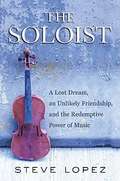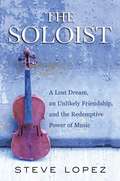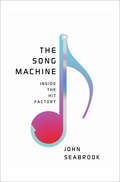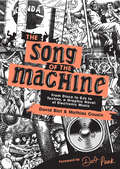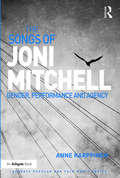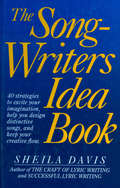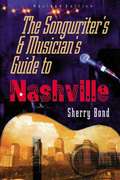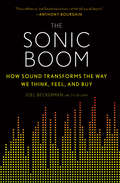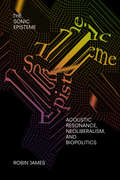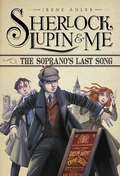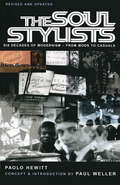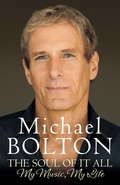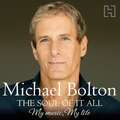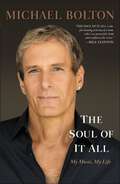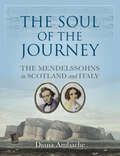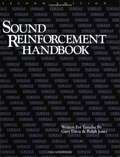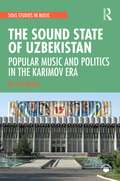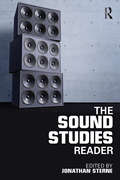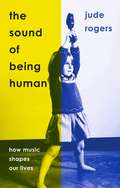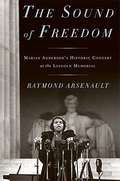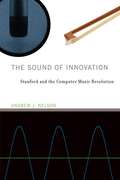- Table View
- List View
The Soloist (Movie Tie-In): A Lost Dream, an Unlikely Friendship, and the Redemptive Power of Music
by Steve LopezNow a major motion picture-"An intimate portrait of mental illness, of atrocious social neglect, and the struggle to resurrect a fallen prodigy." (Mark Bowden, author of Black Hawk Down) This is the true story of journalist Steve Lopez's discovery of Nathaniel Ayers, a former classical bass student at Julliard, playing his heart out on a two-string violin on Los Angeles' Skid Row. Deeply affected by the beauty of Ayers's music, Lopez took it upon himself to change the prodigy's life-only to find that their relationship has had a profound change on his own life.
The Soloist: A Lost Dream, an Unlikely Friendship, and the Redemptive Power of Music
by Steve LopezWhen reporter Steve Lopez sees Nathaniel Ayers playing his heart out on a 2-string violin in LA's Skid Row, he finds it impossible to walk away. At first, he sees it as fodder for his column, but what Lopez begins to unearth about the mysterious street musician leaves an indelible impression. More than 30 years earlier, Ayers had been a promising classical bass student at Juilliard - ambitious, charming, and one of the few African-Americans at the school - until he gradually lost his ability to function, overcome by a mental breakdown. When Lopez finds him, Ayers is alone, suspicious of everyone, and deeply troubled, but glimmers of brilliance are still there.
The Sonata
by Thomas Schmidt-BesteWhat is a sonata? Literally translated, it simply means 'instrumental piece'. It is the epitome of instrumental music, and is certainly the oldest and most enduring form of 'pure' and independent instrumental composition, beginning around 1600 and lasting to the present day. Schmidt-Beste analyses key aspects of the genre including form, scoring and its social context - who composed, played and listened to sonatas? In giving a comprehensive overview of all forms of music which were called 'sonatas' at some point in musical history, this book is more about change than about consistency - an ensemble sonata by Gabrieli appears to share little with a Beethoven sonata, or a trio sonata by Corelli with one of Boulez's piano sonatas, apart from the generic designation. However, common features do emerge, and the look across the centuries - never before addressed in a single-volume survey - opens up new and significant perspectives.
The Song Machine: Inside The Hit Factory
by John Seabrook“An utterly satisfying examination of the business of popular music.” —Nathaniel Rich, The Atlantic Over the last two decades a new type of hit song has emerged, one that is almost inescapably catchy. Pop songs have always had a "hook," but today’s songs bristle with them: a hook every seven seconds is the rule. Painstakingly crafted to tweak the brain's delight in melody, rhythm, and repetition, these songs are highly processed products. Like snack-food engineers, modern songwriters have discovered the musical "bliss point." And just like junk food, the bliss point leaves you wanting more. In The Song Machine, longtime New Yorker staff writer John Seabrook tells the story of the massive cultural upheaval that produced these new, super-strength hits. Seabrook takes us into a strange and surprising world, full of unexpected and vivid characters, as he traces the growth of this new approach to hit-making from its obscure origins in early 1990s Sweden to its dominance of today's Billboard charts. Journeying from New York to Los Angeles, Stockholm to Korea, Seabrook visits specialized teams composing songs in digital labs with new "track-and-hook" techniques. The stories of artists like Katy Perry, Britney Spears, and Rihanna, as well as expert songsmiths like Max Martin, Stargate, Ester Dean, and Dr. Luke, The Song Machine shows what life is like in an industry that has been catastrophically disrupted—spurring innovation, competition, intense greed, and seductive new products. Going beyond music to discuss money, business, marketing, and technology, The Song Machine explores what the new hits may be doing to our brains and listening habits, especially as services like Spotify and Apple Music use streaming data to gather music into new genres invented by algorithms based on listener behavior. Fascinating, revelatory, and original, The Song Machine will change the way you listen to music.
The Song of the Machine: From Disco to DJs to Techno, a Graphic Novel of Electronic Music
by David Blot Mathias CousinA pulsating graphic novel on the epic history of electronic music, from the heyday of disco in the 1970s to the rave culture of the 1990s and beyond.With a foreword from house music legends Daft Punk, The Song of the Machine is a celebration of a musical wave that swept across the world over decades, demographics, and dance styles. Originally published in 2000 in France, and updated through today for this first English edition, the electrifying narrative introduces readers to the harbingers of the genre, such as David Mancuso, Larry Levan, and Frankie Knuckles (known as the "Godfather of House Music"); the prototypes of modern-day nightclubs and dance venues, like The Loft and Studio 54 in New York City, the Palace in Paris, and the Hacienda in Manchester, England, and of course, the technology and machines that first produced and synthesized the records that galvanized a movement. Told through exciting illustrations that evolve with the era they describe, and complete with specially curated playlists for each and every decade, The Song of the Machine recounts the influences and inspirations, the people and epic parties that created and defined this revolutionary music.
The Songs of Blind Folk: African American Musicians and the Cultures of Blindness (Corporealities: Discourses on Disability)
by Terry RowdenThe Songs of Blind Folk explores the ways that the lives and careers of blind and visually impaired African American musicians and singers have mirrored the changes in America's image of African Americans and the social positioning and possibilities of the entire black community. The book offers a historically grounded consideration of African American performers and their audiences, and the ways that blindness, like blackness, has affected the way the music has been produced and received. This book includes footnotes which contain considerable information; be sure to read them. Author Terry Rowden considers the controversial nineteenth-century prodigy Blind Tom Bethune; blues singers and songwriters such as Blind Lemon Jefferson, who achieved an unprecedented degree of visibility and acceptance in the 1920s and '30s; spiritual and gospel musicians such as the Blind Boys of Alabama; celebrated jazz and rhythm and blues artists Art Tatum, Rahsaan Roland Kirk, and Ray Charles; and finally, perhaps the best known of all blind performers, Stevie Wonder. Terry Rowden is Assistant Professor of English at the City University of New York, Staten Island. He is coeditor of Transnational Cinema: The Film Reader.
The Songs of Joni Mitchell: Gender, Performance and Agency (Ashgate Popular and Folk Music Series)
by Anne KarppinenAn unorthodox musician from the start, singer-songwriter Joni Mitchell's style of composing, performing, and of playing (and tuning) the guitar is unique. In the framework of sexual difference and the gendered discourses of rock this immediately begs the questions: are Mitchell's songs specifically feminine and, if so, to what extent and why? Anne Karppinen addresses this question focusing on the kind of music and lyrics Mitchell writes, the representation of men and women in her lyrics, how her style changes and evolves over time, and how cultural context affects her writing. Linked to this are the concepts of subjectivity and authorship: when a singer-songwriter sings a song in the first person, about whom are they actually singing? Mitchell offers a fascinating study, for the songs she writes and sings are intricately woven from the strands of her own life. Using methods from critical discourse analysis, this book examines recorded performances of songs from Mitchell's first nine studio albums, and the contemporary reviews of these albums in Anglo-American rock magazines. In one of the only books to discuss Mitchell's recorded performances, with a focus that extends beyond the seminal album Blue, Karppinen explores the craft of Mitchell's songwriting and her own attitudes towards it, as well as the dynamics and politics of rock criticism in the 1960s and 1970s more generally.
The Songs of Stephen C. Foster: from His Time to Ours
by William W. AustinWith some elements of biography of Stephen C. Foster, and his simple musical techniques, this book has a pattern that gives more emphasis to poetry, to history, and to cultural contrasts and connections during his time.
The Songwriter's Idea Book
by Sheila DavisIn her first two books, Sheila Davis classified the major song forms and enduring principles that have been honored for decades by America's foremost songwriters. Those books have become required reading in music courses from NYU to UCLA. In The Songwriters Idea Book, Davis goes one step further, giving you 40 strategies for designing distinctive songs. You'll break new ground in your own songwriting by learning about the inherent relationship between language style, personality type and the brain. You'll go, step by step, through the creative process as you activate, incubate, separate and discriminate. You'll learn to use the whole-brain techniques of imaging, brainstorming and clustering. You'll expand your skilled use of figurative language with paragrams, metonyms, synecdoche and antonomasia. You'll be challenged to design metaphors, form symbols, make puns and coin words. And, you'll learn how to prevent writer's block, increase your productivity and maintain your creative flow. Over 100 successful student lyrics from pop, country, cabaret, and theater serve as role-models to illustrate the "whole-brain" songwriting process.
The Songwriter's and Musician's Guide to Nashville: Third Edition
by Sherry BondThis behind-the scenes look at the Nashville music industry reveals inside tips on how to break through the system and get heard. The new edition includes the latest strategies for Internet marketing, best techniques for pitching songs and artist packages, and more. Songwriters and musicians learn how to get their songs heard in Music City, USA, and find the industry's decision makers.
The Sonic Boom: How Sound Transforms the Way We Think, Feel, and Buy
by Tyler Gray Joel BeckermanA fascinating study on the influence of sound—and how companies wrangle its power to affect our moods, our shopping habits, and our lives. From movie scores and national anthems to cell-phone dings and squeaky shoes, sound and music impact how we perceive the stories, situations, and products we encounter every day. In The Sonic Boom, composer and strategic sound expert Joel Beckerman reveals sound&’s surprising power to influence our decisions, opinions, and actions in ways we might not even notice: discordant ambient noise can induce anxiety; ice cream truck jingles can bring you back to your childhood. You don&’t need to be a musician or a composer to harness the power of sound. Companies, brands, and individuals can strategically use sound to get to the core of their mission, influence how they&’re perceived by their audiences, and gain a competitive edge. Whether you&’re a corporate giant connecting with millions of customers or a teacher connecting with one classroom of students, the key to an effective sonic strategy is the creation of &“boom moments&”—transcendent instants when sound connects with a listener&’s emotional core. &“Equal parts sociological study and business advice, using unique everyday examples—for instance, how the fate of the Chili&’s fajita empire rested on the sound of the sizzling platter, and how Disneyland approaches soundscapes for a fully immersive experience—to explain how sound effects our mood and shopping habits.&” —Entertainment Weekly &“Music defines us. Joel Beckerman knows. Let him tell you all about it.&” —Anthony Bourdain &“The Sonic Boom reveals the music and structured cacophony of everyday life.&” —Moby
The Sonic Episteme: Acoustic Resonance, Neoliberalism, and Biopolitics
by Robin JamesIn The Sonic Episteme Robin James examines how twenty-first-century conceptions of sound as acoustic resonance shape notions of the social world, personhood, and materiality in ways that support white supremacist capitalist patriarchy. Drawing on fields ranging from philosophy and sound studies to black feminist studies and musicology, James shows how what she calls the sonic episteme—a set of sound-based rules that qualitatively structure social practices in much the same way that neoliberalism uses statistics—employs a politics of exception to maintain hegemonic neoliberal and biopolitical projects. Where James sees the normcore averageness of Taylor Swift and Spandau Ballet as contributing to the sonic episteme's marginalization of nonnormative conceptions of gender, race, and personhood, the black feminist political ontologies she identifies in Beyoncé's and Rihanna's music challenge such marginalization. In using sound to theorize political ontology, subjectivity, and power, James argues for the further articulation of sonic practices that avoid contributing to the systemic relations of domination that biopolitical neoliberalism creates and polices.
The Soprano's Last Song
by Irene AdlerIrene Adler, Sherlock Holmes, and Arsene Lupin plan to reunite in London, but Lupin doesn't show up ... his father, Theophraste, has been arrested for murder.
The Soul Stylists: Six Decades of Modernism - From Mods to Casuals
by Paolo HewittThe Soul Stylists is about six decades of Modernism and a highly influential world of clothes and music, but one deliberately hidden away for years from the mainstream media. This book explores the enduring relationship that exists between American black music and British working-class style, tracing a Mod tradition that began in Soho just after the Second World War and continues to this day. From Mod to Casual, from Skinhead to Northern Souler, the soul stylists are an amazing family joined together by a tradition of secrecy, exclusivity and absolute indifference towards the outside world. They pass unnoticed because soul stylists always shun the spotlight. To them, attention to detail is far more important than attention seeking. And here in this book, for the very first time, are some of their stories.
The Soul of It All: My Music, My Life
by Michael BoltonAfter four decades in the music industry, Michael Bolton has cemented himself as one of the most successful musicians of our time. THE SOUL OF IT ALL is his backstage pass into his life lived thus far - into the venues, buses, limos and hotel rooms of stardom, and finally into his home and heart. His story will go long and dive deep, not only into his self-proclaimed 'vagabond vampire' life, but also into the belly of the beast that is the music industry, with its joys, follies and torments.From a 14-year-old kid performing in dive bars to struggling to provide for his wife and kids, to finally breaking through with the Soul Provider album, Bolton has fought for and earned a life most just dream of. THE SOUL OF IT ALL is his life, chockful of all the incredible stories, and the star-studded cast you'd expect, including: Pavarotti, Bob Dylan, Barbra Streisand, Celine Dion, Ray Charles and Lady Gaga.
The Soul of It All: My Music, My Life
by Michael BoltonAfter four decades in the music industry, Michael Bolton has cemented himself as one of the most successful musicians of our time. THE SOUL OF IT ALL is his backstage pass into his life lived thus far - into the venues, buses, limos and hotel rooms of stardom, and finally into his home and heart. His story will go long and dive deep, not only into his self-proclaimed 'vagabond vampire' life, but also into the belly of the beast that is the music industry, with its joys, follies and torments.From a 14-year-old kid performing in dive bars to struggling to provide for his wife and kids, to finally breaking through with the Soul Provider album, Bolton has fought for and earned a life most just dream of. THE SOUL OF IT ALL is his life, chockful of all the incredible stories, and the star-studded cast you'd expect, including: Pavarotti, Bob Dylan, Barbra Streisand, Celine Dion, Ray Charles and Lady Gaga.
The Soul of It All: My Music, My Life
by Michael BoltonAfter four decades in the music industry, Michael Bolton has become one the most successful musicians of our time. THE SOUL OF IT ALL is his backstage pass into his life lived thus far-into the venues, busses, limos, and hotel rooms of stardom, and finally into his home and heart. His story will go long and dive deep, not only into his self-proclaimed "vagabond vampire" life, but also into the belly of the beast that is the music industry, with its joys, follies, and torments.From a 14 year old kid performing in dive bars in his hometown of New Haven, CT, to struggling to provide for his wife and kids, to finally breaking through with the Soul Provider album, and going on to sell more than 53 million albums and singles worldwide, Bolton has fought for and earned a life most just dream of. THE SOUL OF IT ALL is his life, chock-full of all the incredible stories, and the star-studded cast you'd expect, including: Luciano Pavarotti, Paula Abdul, Cher, Bob Dylan, Barbara Streisand, Kanye West, Jay-Z, Lady Gaga, Otis Redding, Ray Charles, Placido Domingo, Renee Fleming, Bon Jovi, Wynonna Judd, BB King, Patti LaBelle, Carlos Santana, Nicolette Sheridan, Teri Hatcher and others...
The Soul of the Journey: The Mendelssohns in Scotland and Italy
by Diana AmbacheBrother and sister Felix and Fanny Mendelssohn enjoyed a rare bond: they were intimate companions and theirs was one of the most significant musical relationships of the 19th century. They shared and commented on each other’s compositions, each highly appreciative of the other but also offering frank, critical advice. Their travels produced some great music – Felix’s best loved works, the Hebrides Overture and the Scottish Symphony, were inspired by his 1829 visit to Scotland, whilst Fanny’s innovative piano cycle Das Jahr was a musical response to the tour of Italy she made in 1839–40. Combining letters and sketches with an accompanying narrative describing their journeys, this is a wonderful celebration of the two Mendelssohns and a portrait of Scotland and Italy of the time as seen through the eyes of two of the Romantic movement’s most acclaimed composers.
The Sound Reinforcement Handbook
by Ralph Jones Gary DavisSound reinforcement is the use of audio amplification systems. This book is the first and only book of its kind to cover all aspects of designing and using such systems for public address and musical performance. The book features information on both the audio theory involved and the practical applications of that theory, explaining everything from microphones to loudspeakers. This revised edition features almost 40 new pages and is even easier to follow with the addition of an index and a simplified page and chapter numbering system. New topics covered include: MIDI, Synchronization, and an Appendix on Logarithms.
The Sound State of Uzbekistan: Popular Music and Politics in the Karimov Era (SOAS Studies in Music Series)
by Kerstin KlenkeThe Sound State of Uzbekistan: Popular Music and Politics in the Karimov Era is a pioneering study of the intersection between popular music and state politics in Central Asia. Based on 20 months of fieldwork and archival research in Tashkent, this book explores a remarkable era in Uzbekistan’s politics (2001–2016), when the Uzbek government promoted a rather unlikely candidate to the prominent position of state sound: estrada, a genre of popular music and a musical relic of socialism. The political importance it attached to estrada was matched by the establishment of an elaborate bureaucratic apparatus for state oversight. The Sound State of Uzbekistan shows the continuing legacy of Soviet concepts to frame the nexus between music, artists and the state, and explains the extraordinary potency ascribed to estrada. At the same time, it challenges classical readings of transition and also questions common binary models for researching culture in totalitarian or authoritarian states. Proposing to approach lives in music under authoritarianism as a form of normality instead, the author promotes a post-Cold War paradigm in music studies.
The Sound Studies Reader
by Jonathan SterneThe Sound Studies Reader blends recent work that self-consciously describes itself as ‘sound studies’ along with earlier and lesser-known scholarship on sound from across the humanities and social sciences. The Sound Studies Reader touches on key themes like noise and silence; architecture, acoustics and space; media and reproducibility; listening, voices and disability; culture, community, power and difference; and shifts in the form and meaning of sound across cultures, contexts and centuries. Writers reflect on crucial historical moments, difficult definitions, and competing accounts of the role of sound in culture and everyday life. Across the essays, readers will gain a sense of the range and history of key debates and discussions in sound studies. The collection begins with an introduction to welcome novice readers to the field and acquaint them the main issues in sound studies. Individual section introductions give readers further background on the essays and an extensive up to date bibliography for further reading in sound studies make this an original and accessible guide to the field.
The Sound of Being Human: How Music Shapes Our Lives
by Jude Rogers'Too often we treat popular music as wallpaper surrounding us as we live our lives. Jude Rogers shows the emotional and cerebral heft such music can have. It's a personal journey which becomes universal. Fascinating' Ian Rankin'Moving and absorbing, The Sound of Being Human mixes memoir, analysis, anecdote and personal chronicle into a mosaic that evokes what music means to the individual and the human tribe. A candid, beautiful read' Stuart MaconieThe Sound of Being Human explores, in detail, why music plays such a deep-rooted role in so many lives, from before we are born to our last days. At its heart is Jude's own story: how songs helped her wrestle with the grief of losing her father at age five; concoct her own sense of self as a lonely adolescent; sky-rocket her relationships, both real and imagined, in the flushes of early womanhood, propel her own journey into working life, adulthood and parenthood, and look to the future.Shaped around twelve songs, ranging from ABBA's 'Super Trouper' to Neneh Cherry's 'Buffalo Stance', Kraftwerk's 'Radioactivity' to Martha Reeves and the Vandellas' 'Heat Wave', the book combines memoir and historical, scientific and cultural enquiry to show how music can shape different versions of ourselves; how we rely upon music for comfort, for epiphanies, and for sexual and physical connection; how we grow with songs, and songs grow inside us, helping us come to terms with grief, getting older and powerful memories. It is about music's power to help us tell our own stories, whatever they are, and make them sing.
The Sound of Being Human: How Music Shapes Our Lives
by Jude Rogers'Too often we treat popular music as wallpaper surrounding us as we live our lives. Jude Rogers shows the emotional and cerebral heft such music can have. It's a personal journey which becomes universal. Fascinating' Ian Rankin'Moving and absorbing, The Sound of Being Human mixes memoir, analysis, anecdote and personal chronicle into a mosaic that evokes what music means to the individual and the human tribe. A candid, beautiful read' Stuart MaconieThe Sound of Being Human explores, in detail, why music plays such a deep-rooted role in so many lives, from before we are born to our last days. At its heart is Jude's own story: how songs helped her wrestle with the grief of losing her father at age five; concoct her own sense of self as a lonely adolescent; sky-rocket her relationships, both real and imagined, in the flushes of early womanhood, propel her own journey into working life, adulthood and parenthood, and look to the future.Shaped around twelve songs, ranging from ABBA's 'Super Trouper' to Neneh Cherry's 'Buffalo Stance', Kraftwerk's 'Radioactivity' to Martha Reeves and the Vandellas' 'Heat Wave', the book combines memoir and historical, scientific and cultural enquiry to show how music can shape different versions of ourselves; how we rely upon music for comfort, for epiphanies, and for sexual and physical connection; how we grow with songs, and songs grow inside us, helping us come to terms with grief, getting older and powerful memories. It is about music's power to help us tell our own stories, whatever they are, and make them sing.
The Sound of Freedom: Marian Anderson, the Lincoln Memorial, and the Concert that Awakened America
by Raymond ArsenaultAward-winning civil rights historian Ray Arsenault describes the dramatic story behind Marian Anderson's concert at the Lincoln Memorial--an early milestone in civil rights history--on the seventieth anniversary of her performance. On Easter Sunday 1939, the brilliant vocalist Marian Anderson sang before a throng of seventy-five thousand at the Lincoln Memorial in Washington--an electrifying moment and an underappreciated milestone in civil rights history. Though she was at the peak of a dazzling career, Anderson had been barred from performing at the Daughters of the American Revolution's Constitution Hall because she was black. When Eleanor Roosevelt resigned from the DAR over the incident and took up Anderson's cause, however, it became a national issue. Like a female Jackie Robinson--but several years before his breakthrough--Anderson rose to a pressure-filled and politically charged occasion with dignity and courage, and struck a vital blow for civil rights. In the 1963 March on Washington, Martin Luther King would follow, literally, in Anderson's footsteps. This tightly focused, richly textured narrative by acclaimed historian Raymond Arsenault captures the struggle for racial equality in 1930s America, the quiet heroism of Marian Anderson, and a moment that inspired blacks and whites alike. You can find this concert on YouTube.
The Sound of Innovation
by Andrew J. NelsonIn the 1960s, a team of Stanford musicians, engineers, computer scientists, and psychologists used computing in an entirely novel way: to produce and manipulate sound and create the sonic basis of new musical compositions. This group of interdisciplinary researchers at the nascent Center for Computer Research in Music and Acoustics (CCRMA, pronounced "karma") helped to develop computer music as an academic field, invent the technologies that underlie it, and usher in the age of digital music. In The Sound of Innovation, Andrew Nelson chronicles the history of CCRMA, tracing its origins in Stanford's Artificial Intelligence Laboratory through its present-day influence on Silicon Valley and digital music groups worldwide. Nelson emphasizes CCRMA's interdisciplinarity, which stimulates creativity at the intersections of fields; its commitment to open sharing and users; and its pioneering commercial engagement. He shows that Stanford's outsized influence on the emergence of digital music came from the intertwining of these three modes, which brought together diverse supporters with different aims around a field of shared interest. Nelson thus challenges long-standing assumptions about the divisions between art and science, between the humanities and technology, and between academic research and commercial applications, showing how the story of a small group of musicians reveals substantial insights about innovation. Nelson draws on extensive archival research and dozens of interviews with digital music pioneers; the book's website provides access to original historic documents and other material.
